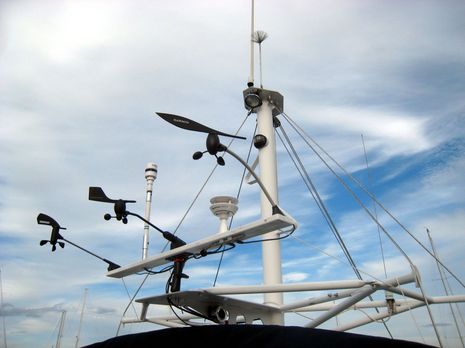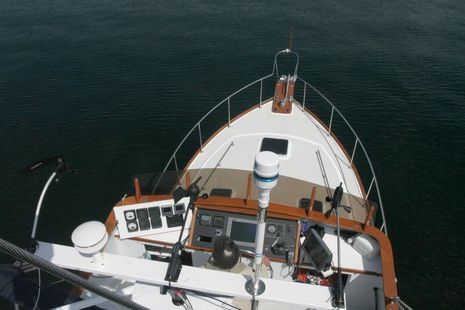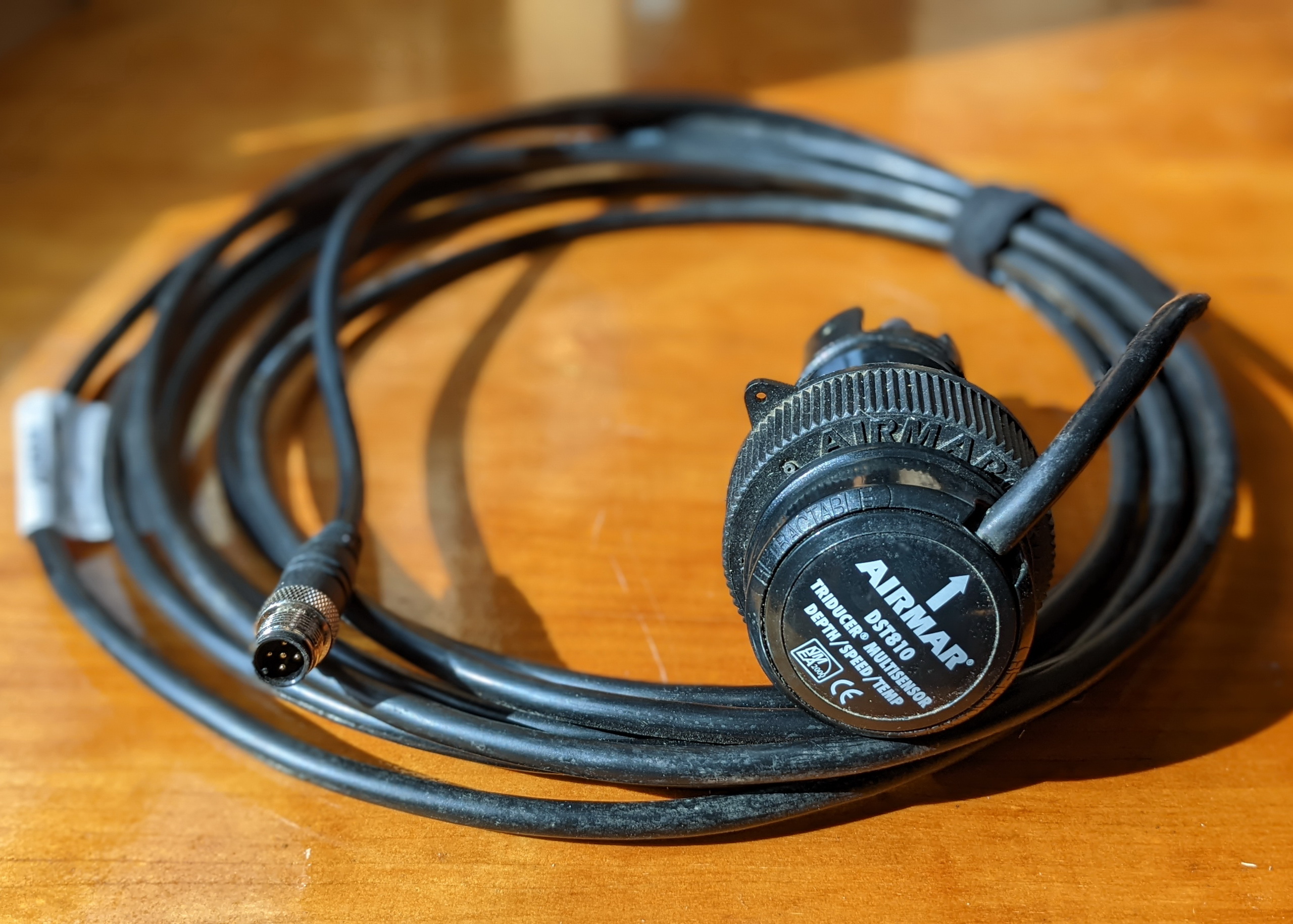N2K wind #1, Gizmo testing begins (update)
Yes, this rig is raising some eyebrows around Camden Harbor, but I think it will teach me more about NMEA 2000 wind sensors than I’ve been able to figure out in the lab. I’ve got all five cabled to the test instrument panel as well as a MFD or two and Gizmo’s laptop. And you can see that I can at least theoretically simulate sailboat mast heel and motion thanks to the Ram Mount. I’m not expecting to get wind-tunnel-accurate results here, but it should be interesting. Don’t hesitate with suggestions on how to use this rig and what to look for; I should be online much of the day, and may even update this entry from the boat. Good times…
Note, as mentioned the other day, how stripped Gizmo’s mast is. Pretty soon I’ll need to figure out how to fit a changing variety of radomes, comms antennas, and other hardware. Do I need to keep that “lightning dissipater”? (Some say they work, some say they don’t.) Can the VHF, AIS, WiFi, and cellular antennas perform well at the spreader level, or should some be at the mast head? Any suggestions for a manly horn to replace that sickly electric one now mounted under the radome platform? How the heck did I end up with a mast this cool? Later…
I spend a few very pleasant hours on the Bay with the N2K wind rig (and my buddy Max), but a fair bit of that time was used up getting the instruments to each display a particular sensor’s output, making sure the calibrations were at default, and double checking angle-to-boat offsets. Once we could see all five sensors on side-by-side displays, the notable thing was how very similar they performed in a variety of true and apparent wind conditions. And I did go up the mast and manhandle the sensor board. I’m going back out early tomorrow for more testing (and screen photography), but I’m beginning to think that the important differences amongst these sensor/display systems have to do with installation details, ease of use and calibration, display preferences, etc. And of course they all put their data on the N2K bus, which is a good thing. Tomorrow…















Do you have a way to spin that 180 degrees? I suppose you could simulate going downwind (without an interuption of air flow over the mast) if you could spin the rig 180 degrees and drive backwards. Doing so might answer the question does angling those vane’s foward disadvantage their downwind measurement performance of wind angle or wind speed at 180, 150 or 130 degrees (apparent). Is the answer yes/no always, or subject to wind velocity … e.g. in 5,10,15,20 knots (apparent)
Ben Asks: Do I need to keep that “lightning dissipater”? (Some say they work, some say they don’t.)
–> I strongly believe they don’t work. Could that be integrated with a hat to match your hat with the propeller?
Ben Asks: Can the VHF, AIS, WiFi, and cellular antennas perform well at the spreader level, or should some be at the mast head?
–> How about testing at the stern rail also? Is the range that is gained significant for purposes of crash avoidance / worth the effort and cost of install on the mast?
Check your email, sent you some recent information about wind testing.
No question on the horn if you can stomach the upfront cost. Don’t you deserve a Father’s Day present? Head over to Hamilton Marine and check out the Kahlenberg’s. They sure do clear the way in a fog bank. We were crossing in front of Bass Harbor and watching on radar a small target heading out. The horn sounded and the target did a U-turn. Recommend an automatic timer to go with he horn as well.
Ben Asks: Do I need to keep that “lightning dissipater”? (Some say they work, some say they don’t.)
–> I strongly believe they don’t work. Could that be integrated with a hat to match your hat with the propeller?
… we can get a picture together wearing hats, with me wearing the new hat. (I have no worries I would be struck by lightening)
The NOAA Data Buoy Office 40 years ago was testing anemometers. We found that differences in the threshold response (minimum wind speed, effects of motion (angle of attack), and the effects of rain could be noticeable. No anemometer except the Bendix Aerovane could survive 200 knot winds. Finally no instrument lasts forever, Do you have the space and time to get a handle on long term reliability?
Enjoy you testing, you will turn a few heads.
As a postscript we had a test platform (an old jalopy) with up to six anemometers mounted on the roof. a 10 channel strip chart recorder on the front seat with a 32 gallon trash can filled with water and a pump attached to a sprinkler on the hood to simulate rain. High speed runs on bad roads was our shock and vibration testing.
Pat Harman
I couldn’t tell from your description of the test set-up, but the ability to record data from all units simultaneously would be important. Subtle differences may only show up by having the flexibility to compare any unit at any time slice.
What would up the ante, have a B&G 213 as your control group. The 213 is the defacto standard in yacht racing circles (and not a n2k device).
ems
It would be interesting to see how accurately you can measure true wind direction with the various sensors, as you cruise around in different directions (simulating a sailboat). I have a theory that the sensors that have everything integrated (compass and GPS) should do this easily, whereas the conventional sensors require very careful calibration.
OK, I’ve asked for advice from a noted editor on “fair use” of someone else’s work, in this case an article published in a magazine. However, given the ephemeral nature of blog evolutions, and since that advice hasn’t been received, I’ll take a chance on forgiveness. Therefore:
Regarding the trivial issue of retaining or not the dissapater, it goes like this…
As long as there is a grounded metal object above the dissapater it is almost certainly of little or no use. In your photo there is an antenna projecting above the dissapater; therefore you might as well do away with the dissapater.
Without expressing an opinion as to whether or not these things actually work, the following — written for a different application but equally valid for the electrostatic fields associated with lightning — are the best analog to what is happening with boat protection from lightning that I am aware of. So here it is from an article by Frank Gentges published in QST, the amateur radio journal:
“Best LF performance is obtained if the
antenna whip is higher than nearby conducting
objects. Imagine pulling a giant
plastic sheet over your house and yard.
The whip should be above this imaginary
sheet. A more accurate (and much more
complex) way to think of it is to imagine
a large metal sheet several hundred feet
above your house and yard (play along).
Now imagine that the sheet is charged
with a high dc voltage. If you were to
examine the electrostatic field around and
above your house and yard, you would
discover that those points below the plastic
sheet are at a 0-V field potential.”
Gentges advise for LF antenna placement coincides with Furuno’s regarding placement of couplers for LORAN and DGPS MF beacon antennas which Furuno recommends be above all other structure on the boat.
So there it is. I know that if the lightning dissapater isn’t the highest conductive item on the boat it probably is useless. If it were would it be useful? Maybe someone else here has that answer!
Cheers,
Richard D
I wholeheartedly agree with Tom C’s recommendation of Kahlenberg horns. Kahlenberg Brothers Co. has been manufacturing ships whistles, horns, propellers and other boat bits since 1895 in Two Rivers, Wisconsin, near the Lake Michigan shore. Their air horns are the Rolls Royce of the industry and standard equipment on U.S. Navy vessels and many luxury yachts and commercial ships as well.
Kahlenberg’s air horns are displayed on their website at http://www.kahlenberg.com/yacht.html. Not only can you find horn specifications there, you can also listen to sound clips of each horn model. WARNING: you won’t want a flimsy knock-off after hearing these beautiful horns.
Kahlenberg has an interesting history. The family-run business was retained in the 1990s to examine and refurbish the original brass ship’s whistles from the Titanic. The whistles were discovered in 1987 in the Titanic’s debris field, 2 1/2 miles below the ocean surface, and brought to the surface in 1993. The whistles hadn’t been heard since the Titanic sank in 1912.
To kick off a touring exhibit of Titanic relics, exhibit promoters wanted to sound the whistles once more. However, the whistles had been on the ocean bottom for 83 years and it was feared that sounding them might severely damage them. So, Kahlenberg was commissioned to examine the whistles and determine whether they could be safely sounded.
After a thorough cleaning and x-rays, Kahlenberg conducted detailed airflow tests on the whistles. The tests did uncover some internal whistle damage, but Kahlenberg was of the opinion that they would not be damaged by one more sounding.
With great fanfare, the Titanic whistles were successfully sounded in 1999 before an audience of thousands in St. Paul, Minnesota. The whistle sounds were also recorded for posterity.
To prevent further damage to these irreplaceable artifacts, the whistles will not be sounded again. But Kahlenberg was commissioned to create three exact replicas of the whistles. The replicas traveled with the exhibit and could be safely sounded without fear of damaging the originals.
One of my favorite suppliers, Landfall Navigation, has this description for the dissipater (partial description shown here)
http://www.landfallnavigation.com/dissipaters.html
It sounds like snake oil to me … “Lightning Master Static Dissipaters lower the exposure to a direct lightning strike by controlling the conditions which trigger direct strikes (i.e. they reduce the buildup of static ground charge and retard the formation of the ion “streamers” which complete the path for a lightning strike.
Snake oil I say.
I’m with Dan. After installing a lightning rod (“air terminal”) with the proper connections to ground (which is easier said than done on a non-metal boat), THEN one could put a static dissipator on the lightning rod and say “what harm could it do?”. But without doing all that the guy who puts one up THINKS he is protected and he is not.
How do you plan to capture all that data, Ben?
“What would up the ante, have a B&G 213 as your control group. The 213 is the defacto standard in yacht racing circles (and not a n2k device).”
Defacto standard huh? Well, they might be accurate when working, but I can’t tell you how many circuit boards Iv’e repaired out of them due to moisture problems and how many times at the masthead Iv’e removed the top half of the PCB housing and literally dumped water out of them.
Eric
Marine Electronics Tech
I can report that my B&G AWI has been in continuous use for 24 yrs only down for 3 winters. Going strong and very sensitive in light wind.
Lots of support for Kahlenberg Ben, and no one could argue that they are what you’d find on a megayacht, particularly in a five horn mount, but for something a little less yachty and no less the horn take a look at Cunningham. They are a little more of the work boat variety and probably don’t even come chromed but sure sound good. http://www.cunninghamairwhistles.com
As to the lightning dissapater I think I’d leave it. Absolutely can’t hurt and there is always the possibility that it’ll do some good. I do know that hiding among the sailboats just doesn’t work.
Searching the web, there is no support that lightning dissipation devices work, other than the claims of those selling them. There is good support for the claim that they do not work.
This page gives a good summary:
http://wvlightning.com/lmwn4.shtml
“Lightning dissipation / elimination myths”
the problem with these devices is that while they do create corona discharge, the rate of charge ‘leakage’ is completely insignificant in comparison to the rate of charge generation in the 10-mile-high, 15 to 25 mile-diameter thunderstorm overhead! No amount of man-made corona discharge on such a small scale has the slightest chance of draining charge faster than a gargantuan thunderstorm cloud is producing it. And although small-scale corona does help prevent the initiation of laboratory-generated sparks (such as from Van de Graaff generators), this cannot be extrapolated to apply to full-sized lightning discharges, which are several thousand times larger than the artifical counterparts (see our article on comparing artificial and natural lightning). Corona discharge from small ‘dissipators’ is insignificant to a full-sized thunderstorm and will do nothing to alter the occurence or behavior of lightning in its geneeral vicinity.